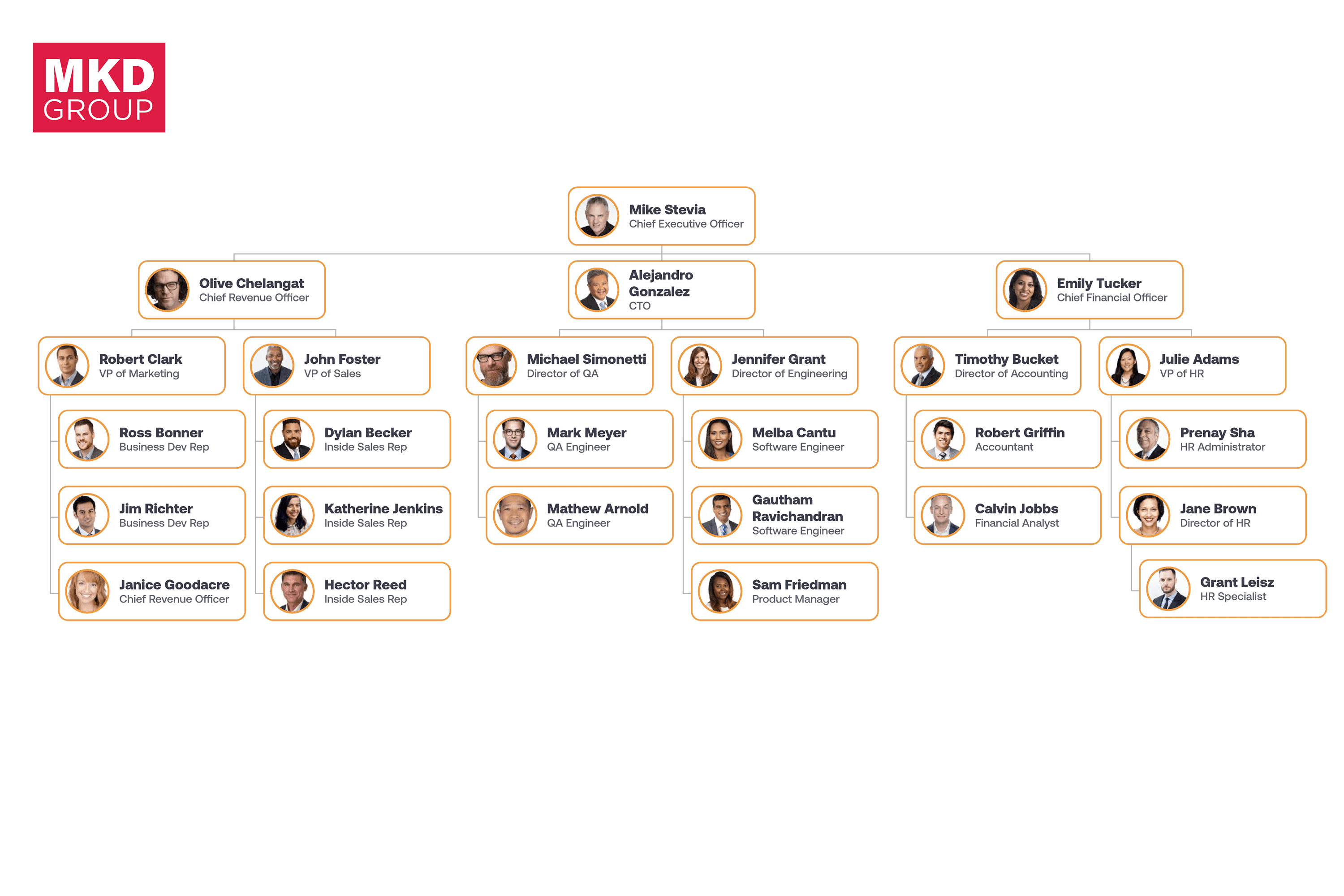OrgChart Team
August 15, 2024
Business growth often comes hand-in-hand with more data complexity, which in turn requires investments in new ways to understand and analyze that information. As needs arise and gaps are identified,…

Business growth often comes hand-in-hand with more data complexity, which in turn requires investments in new ways to understand and analyze that information. As needs arise and gaps are identified, new remits and roles are created, and the organization spreads exponentially. It can be challenging to get a true visual representation of the state of processes and data flows.
Given the range of different sizes and structures of businesses across different industries, HR leaders need ways to easily understand the make-up of the organization if they are to be strategic about talent and growth planning. A human resource diagram can provide that essential information in a visual representation, creating an at-a-glance view of HR concepts, processes and structures that can help to simplify complex organizational information and create better stakeholder understanding.
A human resources diagram visually represents either an internal structure or process, but can also include expected outcomes or required skill sets. For example, a human resources graph for a team structure might feature the names of employees, along with their primary roles and responsibilities. The charts can also represent organizational hierarchies, highlighting any relationships between roles and departments.
These diagrams, graphs and charts can help employees to understand the wider context of their roles, and help business leaders to identify potential talent gaps needing to be filled. In this way, a human resource management diagram aligns HR strategies with organizational goals, making it easier for employees to understand and implement structures, processes, and plans.
Human resources diagrams come in many different forms depending on purpose. These can include:

Human resources diagrams can give a clear picture of how an organization manages its people and its processes, including who does what, and where everything and everyone fits. It’s like having the entire workforce, each of their roles, all of the relationships, or all of the workflows in one place, and so becomes an important asset to aid company strategy and planning.
These visualizations can be especially useful when assessing the human capital of an organization, whether it’s to help see where they fit in the scheme of things, or where there may be gaps that need filling. In this sense, human resource management diagrams are useful to both workforce planning and organizational development. The visual insights can provide clarity around aspects of HR strategy such as organizational structures, resource allocation, talent management, workforce planning, and learning and development needs.
For example, let’s say HR has been tasked with growing the sales arm in anticipation of moving into a new market:
These visual representations are not the end game; rather, they help to inform human resources strategy and planning. They can also bring many benefits to the organization, as outlined below.
With a better understanding of internal structures, hierarchies and reporting lines, HR diagrams can help to improve interdepartmental communication. They can also provide clarity about roles and responsibilities, shed light on a workflow or process, and create opportunities for collaboration. Human resource management process diagrams could even be used to help with conflict resolution.
Given the ever-changing nature of the economy and of organizations, change is inevitable. Yet it can still be disruptive. Human resources data flow diagrams or process diagrams can help to assess shifts in the market, noting areas for upskilling or recruitment, or identifying a need for reorganization.
Do your employees know exactly what’s expected of them, or who they should go to for help in various situations? By clearly defining roles and responsibilities, employees can get to work in a more efficient manner, collaborating with the right people empowered with the knowledge of their specific domain. This can be especially useful for new hires; they can quickly learn what their job entails without having to spend onerous time getting up to speed with operations and processes.
These clearly defined roles and processes can also help improve talent acquisition and human capital management. Human resource management system diagrams such as competency models and accountability charts can lend structure to performance management, team growth, promotion opportunities, and even benefits systems. They can help employees to stay on track to meet career and development goals, which can increase both productivity and employee satisfaction.
One of the big benefits of using human resources diagrams lies in the enhanced decision-making. While workflow chart diagrams can help to outline processes for streamlining operations, visual representations such as fishbone diagrams and cost-benefit analysis diagrams lend credibility and confidence to those making strategic decisions. These diagrams and charts can highlight areas where resources could be better deployed, or even identify the root cause of an issue.
Human resources graphs can help to identify areas for better team work by highlighting redundancies and inefficiencies in current processes, including potential bottlenecks and errors. These human resource management process diagrams can highlight gaps or even duplicated processes and resources, which in turn can then help to increase organizational efficiency and productivity. They can be a secret weapon in strategic planning and alignment.
Through supporting the human resources planning process, and using them to identify and address issues and inefficiencies, human resources graphs drive better planning and better management of human capital and processes across the organization. With hierarchy, roles and responsibilities clarified, HR can move to the important work of maximizing employee skills and opportunities to drive strategic business growth.
They are not, however, a solve-all. There are challenges involved in creating and maintaining human resource diagrams, and these risks should be mitigated from the outset for these important tools to be implemented and used well by the workforce.
Take, for example, data accuracy. An organization is organic; as it grows, and ebbs and flows, its structure and its people move with it. And this evolution can make it difficult to keep your human resource diagrams and charts current and up-to-date when you create them manually, risking incorrect information being used for important strategic decisions.
To mitigate this, it can be wise to turn to technology. Platforms such as OrgChart integrate with HR systems to pull through the most up-to-date information on organizational structures and automate chart creation, meaning that when the human resource diagram is accessed, it reflects the current state of the organization.
Using software such as OrgChart helps to streamline HR operations by automating and customizing real-time human resource diagrams for your entire organization.

Managing Positions in a Company Chart: Strategies for Modern HR Teams…
As companies grow beyond 100 employees, managing organizational structure becomes exponentially more complex. HR professionals need an advanced, dynamic…
Read Article
Restaurant Hierarchy Chart: Structure & Roles…
Restaurants are arguably the busiest businesses out there, with servers, cooks, managers, and executives working hard to ensure every guest has a stellar…
Read Article
Healthcare Organizational Chart: Structure, Examples & How to Build One…
Explore the power of People Analytics. Unlock data-driven HR strategies to optimize your workforce with our tools.…
Read Article